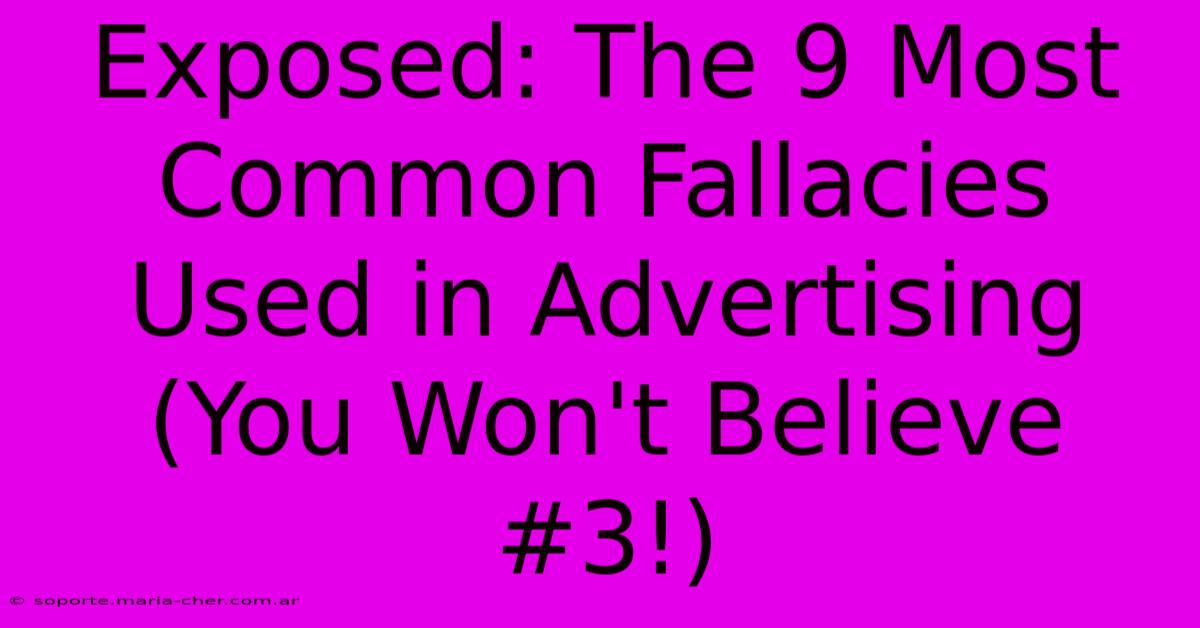Exposed: The 9 Most Common Fallacies Used In Advertising (You Won't Believe #3!)

Table of Contents
Exposed: The 9 Most Common Fallacies Used in Advertising (You Won't Believe #3!)
We're bombarded with advertising messages daily. From catchy jingles to emotionally charged visuals, advertisers employ a range of techniques to persuade us to buy their products or services. But behind the glitz and glamour, many ads rely on logical fallacies – flaws in reasoning that can manipulate our thinking and lead to poor purchasing decisions. This article exposes nine of the most common advertising fallacies, revealing the tricks advertisers use and empowering you to become a more discerning consumer.
1. Bandwagon Fallacy: "Everyone's Doing It!"
This classic fallacy pressures you into believing a product is good simply because it's popular. Ads often showcase large crowds enjoying a product, implying that if everyone else is using it, you should too. Think: "Millions of people can't be wrong!" But popularity doesn't automatically equate to quality. Consider: What are the actual merits of the product itself, separate from its popularity?
2. Appeal to Authority: "A Doctor Recommends..."
This fallacy leverages the credibility of an authority figure (a celebrity, doctor, or expert) to endorse a product, even if that authority lacks genuine expertise in the relevant field. The implication is that if a respected figure uses or recommends it, the product must be good. However: A celebrity endorsement doesn't guarantee product efficacy or safety. Always: Investigate the claims independently and look for verifiable evidence.
3. (You Won't Believe #3!) Appeal to Emotion: Tugging at Your Heartstrings
This is arguably the most powerful and pervasive fallacy. Instead of presenting logical arguments, emotional appeals use heartwarming stories, fear-mongering tactics, or humor to manipulate your feelings and bypass rational thought. Think: Heart-wrenching animal shelter commercials or ads playing on your fear of missing out (FOMO). Be Aware: Emotional appeals often distract from the product's actual qualities.
4. False Dilemma (Either/Or): Limiting Your Choices
This fallacy presents only two options, when in reality, many more exist. Ads might suggest you must choose between their product and a clearly inferior alternative, ignoring better options. Example: "Choose our brand or settle for second best." Challenge: Always consider alternative products and choices before making a decision.
5. Slippery Slope: Exaggerating the Consequences
This fallacy claims that choosing one thing will inevitably lead to a series of negative consequences. Ads might suggest that using a competitor's product will lead to a disastrous outcome, while using their product guarantees safety and success. Be Critical: Assess the likelihood of the claimed chain of events. Are the consequences truly inevitable?
6. Hasty Generalization: Drawing Conclusions from Insufficient Evidence
This fallacy relies on limited or biased data to make broad claims. An ad might feature one satisfied customer and extrapolate that experience to the entire population. Example: "One customer said it changed their life, so it will change yours too!" Demand: Look for more extensive and unbiased evidence before forming an opinion.
7. Red Herring: Distraction from the Real Issue
This fallacy introduces an irrelevant topic to distract from the main issue at hand. An ad might focus on a product's appealing design instead of addressing its actual functionality or performance. Be Vigilant: Focus on the core features and benefits, not superficial distractions.
8. Straw Man: Misrepresenting the Opposition
This fallacy misrepresents the claims of competitors to make their own product look superior. An ad might exaggerate or distort the flaws of competing products, creating a "straw man" argument that is easier to defeat. Verify: Check the competitor's claims independently before accepting the advertised representation.
9. Glittering Generalities: Using Vague Positive Language
This fallacy uses vague, emotionally appealing words without providing specific evidence. Ads might boast about a product being "amazing," "innovative," or "the best," without substantiating those claims. Seek: Specific details, facts, and figures to support any positive descriptions.
By understanding these common advertising fallacies, you can become a more informed and discerning consumer, making purchasing decisions based on logic and reason rather than manipulation. Don't let clever advertising trick you! Always question the claims and look for verifiable evidence before you buy.

Thank you for visiting our website wich cover about Exposed: The 9 Most Common Fallacies Used In Advertising (You Won't Believe #3!). We hope the information provided has been useful to you. Feel free to contact us if you have any questions or need further assistance. See you next time and dont miss to bookmark.
Featured Posts
-
Unlock The Secret To Ear Perfection Elevate Your Style With A Second Piercing
Feb 07, 2025
-
The Internets Oasis Where All Your Cravings Converge
Feb 07, 2025
-
The Ultimate Guide To Empty Effective Flyer Marketing Dominate Google Discovery And Drive Traffic
Feb 07, 2025
-
Raskryt Genialniy Sekret Sozdaniya Fotografiy Idealnogo Razmera
Feb 07, 2025
-
Revolutionize Your Earring Game Discover The Magic Of Second Hole Piercings
Feb 07, 2025
